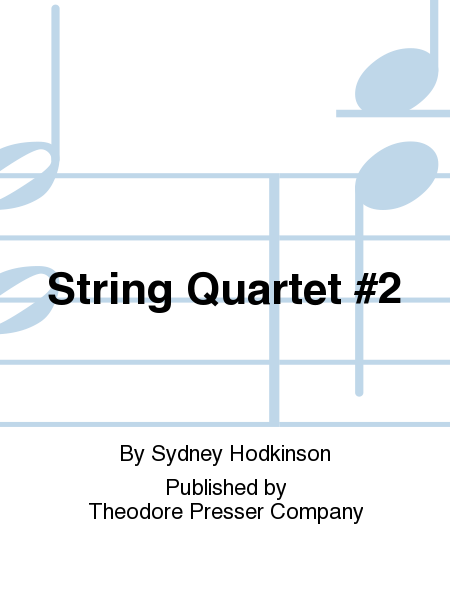String Quartet No. 2
-
Ships in 2 to 3 weeks
Details
Description
SKU: PR.144402650
Composed by Sydney F. Hodkinson. Set of Score and Parts. With Standard notation. Duration 25 minutes. Merion Music #144-40265. Published by Merion Music (PR.144402650).UPC: 680160027897.
The Second and Third Quartets were conceived at the same time; indeed, their composition intermingled, over half of No. 3 being sketched before No. 2 was completed. Accordingly, they share similar material but, like the intertwining blood of cousins, their natures differ: No. 2 being somewhat acerbic and declamatory, No. 3 more lyric and gentler. An annunicatory 'leaping motive' (derived from a motto generated by my name) opens Quartet No. 2 and inhabits the course of the piece as a cyclical binding-force. A five-note motive, usually very deliberate, also keeps recurring like an insistent caller. All three movements are based on tonal centers (I on B and E, II on D, III on C) and the harmonic 'grammar' spoken tends to recall the jazz world of my youth. To hopefully achieve a certain classical ambience was one of the goals of this piece, and all three movements have traditional forms. The first movement is a modified Sonata-Allegro design, with a severely-truncated recapitulation balanced by a lengthy, and decaying Coda. The second movement is a set of strophic variants and an epilogue interspersed with both solo ritornelli and first-movement material (the motto and the five-note motive) in the nature of a fantasia-like 'call-and-response.' It is dedicated to the memory of the American mezzo-soprano Jan DeGaetani. The third movement is a modified Rondo (ABACBA) which evolves out of the opening motto. All three movements make much use of canonic stretti, similar gestures, and repetition. For example, the climax of movement III's Rondo throws the first movement back at us again, as if the players were reluctant to let it go, so that the entire piece could perhaps be viewed as a single large, extended, Sonata movement, with introduction and Coda.
The Second and Third Quartets were conceived at the same time; indeed, their composition intermingled, over half of No. 3 being sketched before No. 2 was completed. Accordingly, they share similar material but, like the intertwining blood of cousins, their natures differ: No. 2 being somewhat acerbic and declamatory, No. 3 more lyric and gentler.An annunicatory ‘leaping motive’ (derived from a motto generated by my name) opens Quartet No. 2 and inhabits the course of the piece as a cyclical binding-force. A five-note motive, usually very deliberate, also keeps recurring like an insistent caller. All three movements are based on tonal centers (I on B and E, II on D, III on C) and the harmonic ‘grammar’ spoken tends to recall the jazz world of my youth.To hopefully achieve a certain classical ambience was one of the goals of this piece, and all three movements have traditional forms. The first movement is a modified Sonata-Allegro design, with a severely-truncated recapitulation balanced by a lengthy, and decaying Coda. The second movement is a set of strophic variants and an epilogue interspersed with both solo ritornelli and first-movement material (the motto and the five-note motive) in the nature of a fantasia-like ‘call-and-response.’ It is dedicated to the memory of the American mezzo-soprano Jan DeGaetani. The third movement is a modified Rondo (ABACBA) which evolves out of the opening motto.All three movements make much use of canonic stretti, similar gestures, and repetition. For example, the climax of movement III’s Rondo throws the first movement back at us again, as if the players were reluctant to let it go, so that the entire piece could perhaps be viewed as a single large, extended, Sonata movement, with introduction and Coda.

 Share
Share